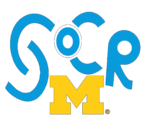Difference between revisions of "SOCR News Neuromatch2.0 2020"
(→Logistics) |
(→Logistics) |
||
| Line 11: | Line 11: | ||
* '''Title''': ''Computational Neuroscience, Time Complexity, and Spacekime Analytics'' | * '''Title''': ''Computational Neuroscience, Time Complexity, and Spacekime Analytics'' | ||
* '''Presenter''': [http://umich.edu/~dinov Ivo Dinov] | * '''Presenter''': [http://umich.edu/~dinov Ivo Dinov] | ||
| + | * '''Slides''': [https://socr.umich.edu/docs/uploads/2020/Dinov_TCIU_SpaceKime_2020_NeuroMatch_2.pdf Talk slidedeck] | ||
== Abstract== | == Abstract== | ||
Revision as of 16:38, 23 May 2020
Contents
SOCR News & Events: Neuromatch 2.0: Spacekime Analytics Short Talk
Logistics
- Event: Neuromatch 2.0 Unconference
- Date/Time: Wednesday, May 27, 2020, 1:40 PM US ET (GMT-4)
- Neuromatch Registration: Neuromatch Registration
- Crowdcast: Neuromatch Crowdcast, Session 28
- Schedule: Neuromatch 2.0 Unconference Program
- Title: Computational Neuroscience, Time Complexity, and Spacekime Analytics
- Presenter: Ivo Dinov
- Slides: Talk slidedeck
Abstract
The immersion of Big Data in all human experiences presents important challenges of managing, modeling, analyzing, interpreting, and visualizing complex information. There is a substantial need to develop, validate, productize, and support novel mathematical techniques, advanced statistical computing algorithms, transdisciplinary tools, and effective artificial intelligence apps.
Spacekime analytics is a new technique for modeling high-dimensional longitudinal data such as functional magnetic resonance imaging (fMRI). This approach relies on extending the notions of time, events, particles, and wavefunctions to complex-time (kime), complex-events (kevents), data and inference-functions. We will illustrate how the kime-magnitude (longitudinal time order) and kime-direction (phase) affect the subsequent predictive analytics and the induced scientific inference. The mathematical foundation of spacekime calculus will reveal various statistical implications including inferential uncertainty and a Bayesian formulation of spacekime analytics. Complexifying time allows the lifting of all commonly observed processes from the classical 4D Minkowski spacetime to a 5D spacetime manifold, where a number of interesting mathematical problems arise.
Direct neuroscience science applications of spacekime analytics will be demonstrated using simulated data and clinical observations (e.g., UK Biobank).
- Joint work with Milen V. Velev (Burgas University, Bulgaria).
Demos
References
- This work is sponsored in part by NIH Grants P30 DK089503, P20 NR015331, R01CA233487, and R01MH121079, as well as, NSF Grants 1916425, 1734853 and 1636840.
- Dinov, ID and Velev, MV (2021) Data Science: Time Complexity, Inferential Uncertainty, and Spacekime Analytics, De Gruyter (STEM Series), Berlin/Boston, ISBN 9783110697803 / 3110697807.
- SOCR Home page: http://www.socr.umich.edu
See also
- General SOCR Webapps
- SOCR BrainViewer
- Motion Charts webapp (try it with your own high-dimensional longitudinal data, e.g., Ozone Data)
- Hands-on interactive visualization of extremely high-dimensional data (learning module and webapp)
- Predicting Hospitalization-based Pressure Injuries (webapp)
- Virtual Hospital and Simulated Patient EHR Data (webapp)
Translate this page:
